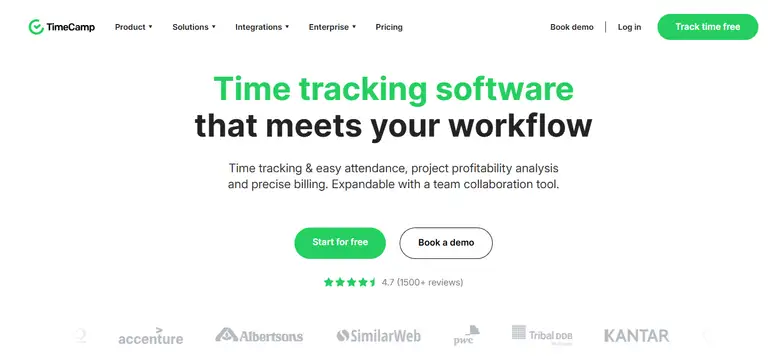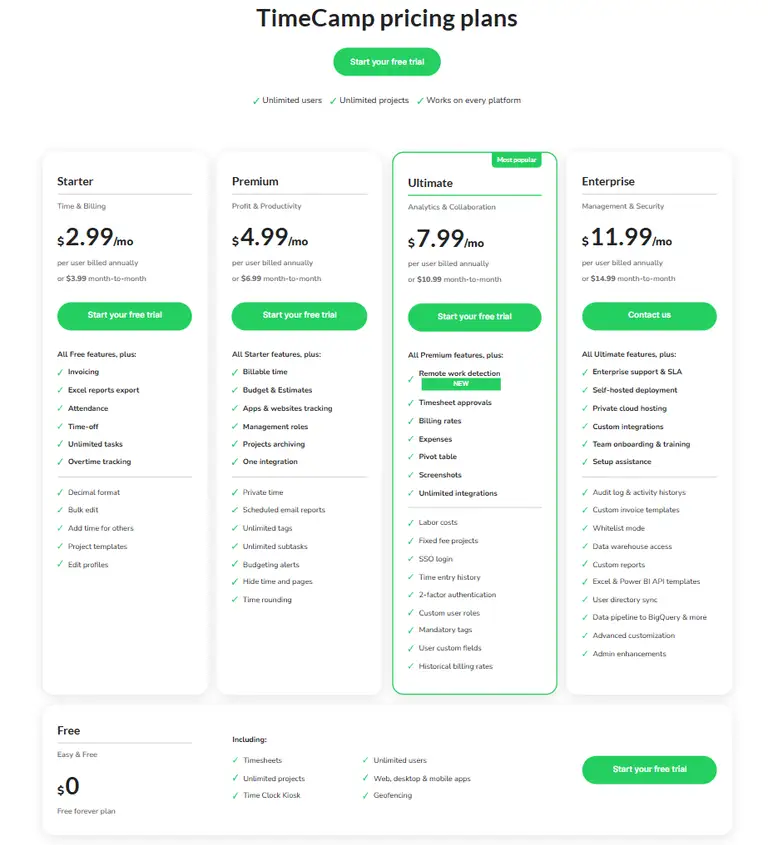Time tracking isn’t exactly the most exciting part of work, but it can decide whether a project makes money or burns hours. That’s where TimeCamp comes in.
With over two decades in the market and plenty of new features in 2025, the tool is aiming to be more than a digital stopwatch. The question is: does it live up to the promise?
Let’s break it down.
TimeCamp: what makes it stand out in 2025?
In a sea of time tracking software, TimeCamp tries to carve out its spot with a mix of automation, reporting, and project management add-ons.
The automatic tracking is a standout: keywords, window titles, and computer activities get logged in the background, turning forgotten timers into a non-issue.
TimeCamp also doubles as light project management software for budgets and team management. It’s not trying to replace Trello or Asana, but it blends nicely with them.
And for managers? Attendance, idle time, and employee performance stats give you a deeper look at team performance without extra tools.

Pricing plans: is TimeCamp worth the cost & is there a free version?
Yes, TimeCamp does have a free version. It covers essential features like unlimited users, time entries, and a TimeCamp desktop app or web app to log hours.
For freelancers or small teams who just want basic features (think idle time checks, automatic tracking, and the chance to create projects), this plan already works. It feels almost like a hidden gem for those testing time tracking software for the first time.
But the story changes when you look at the paid plans.
Starting from a few dollars per month, you get tools that can make or break project profitability. The Starter tier adds invoicing and attendance tracking. Premium moves into project management software designed for growth, so things like project budgets, keyword-based time tracking, and role-based team management. Then comes Ultimate, where TimeCamp offers advanced reporting features, custom tags, and billing rates - all perfect for remote teams juggling many projects at once.
And let’s not forget the enterprise plan. Here it’s less about task management and more about control:
- team collaboration,
- custom roles,
- productivity monitoring,
- and integration with pipelines or BI tools.
It’s built for companies where employee and team performance need to be tracked in one place.
So, is it worth it? If you only want to manage tasks and watch time spent, the free plan will keep you covered. But if your focus is billable hours tracking, project management, or team collaboration across remote teams, the higher tiers with other features are where the real detailed reports and insights kick in.

Automatic time tracking: how accurate is it really?
The TimeCamp desktop app runs in the background and uses keyword-based time tracking. Open a file or browser tab with a keyword you’ve set, and the app logs it to the right project.
Accuracy here means less manual fixing of time entries and fewer “oops, I forgot to start the timer” moments.
The more you set it up (keywords, tasks, projects), the smarter it gets. For teams, this makes billable hours tracking less stressful. You can finally focus on work, while the tracker takes care of computer activities and auto-logs them for project management.
So, how accurate is it? Let’s just say if somebody tries to hide their idle time, TimeCamp will probably spot it before you do.
Offline time tracking: what happens when the internet drops?
The offline time tracking works by letting you keep working and add time entries later. You lose the live feed, but you don’t lose the hours.
It’s not the dream for remote teams who rely on real-time visibility, but it’s still flexible enough to save your workday. When the connection comes back, your time tracking app syncs with the server, updating your projects. Think of it as a diary - you write the hours down, and the system records them properly once it’s back online.
In short: you won’t lose your data, but live productivity monitoring will take a short nap while your internet’s gone.
Attendance tracking and monitoring features
Tracking attendance used to mean paper sheets and messy Excel files. With TimeCamp, it’s part of the flow. Open the app, start working, and the system knows you’re “in.” Stop or shut down, and it clocks you out. Simple as that.
The tool doesn’t stop at presence. It ties attendance to team management. Think monitor attendance, overtime, and even remote work. It builds automatic detailed reports you can export, helping managers spot trends like too much idle time or sudden absences.
For employees, it doubles as a productivity tracking tool. You can see your own hours and adjust your pace.
What’s the real win here? Attendance data becomes more than proof of work. It connects to project budgets and overall team performance.
No more guessing if people showed up or how long they stayed. TimeCamp keeps it precise and useful for both payroll and project management software.
Does TimeCamp's customer support help when you need it?
Mixed, but trending positive. Several users praise the team as helpful and quick to respond. One reviewer said support was “excellent” when working from home and juggling multiple teams, and another mentioned the staff fixing bugs and doing imports when asked.
On the other hand, a recent comment called out customer service as weak, saying it wasn’t a priority.
What does that tell us? You’ll likely get help, yet the experience isn’t perfectly consistent across the board.
If support quality is your deal-breaker, test it during the trial: send a real question, watch the response time, and judge the depth of the reply.
TimeCamp apps: desktop app vs mobile devices experience
On desktop, TimeCamp shines. Reviewers like the window-title tracking and the always-on feel - great for forgetting timers and still capturing time spent. It’s quiet and it helps freelancers and teams keep billable hours tracking clean.
Mobile gets more mixed notes. One user reported the app hanging when stopping a timer, needing a restart. Others call the overall setup easy to use but point to small UI quirks.
Bottom line: the TimeCamp desktop app is the reliable workhorse - the mobile app is handy for quick edits and checks, but it may not be your primary tool for complex days.
Pro tip: if most of your work happens at a desk, lean on desktop and use mobile for light touch-ups.
Integrations, templates, and extra tools
Reviewers highlight strong integrations with Google Calendar, JIRA, Trello, and Zendesk. That means less hopping around and more project management in one track. Exports to Excel make finance folks happy, while invoicing and billing rates support a clean handoff to clients.
Teams also talk up reports: custom periods, cost snapshots, and project profitability views. For repeatable work, project templates and tags help you manage tasks and connect hours back to project budgets. If your day lives inside tools you already use, TimeCamp integrates quite well enough to keep your stack together.
Pros and cons of using TimeCamp
Pros
- Easy to start. Many users said they logged their first hours in minutes, making the time tracker feel accessible right away.
- Great for billing. With options to create invoices, connect to accounting software, and handle billable hours tracking, it makes client work smoother.
- Automation that helps. The auto tracking is a particular feature users highlight: keywords, window titles, and desktop capture reduce manual edits.
- Team-ready. You can track employee attendance, monitor productivity, and use tags, reports, and projects for team management and project management.
- More features. From integrations to templates, it’s not “just another tracker.” Reviewers say some extras feel like they’re available in only TimeCamp.
Cons
- Mobile hiccups. Some users hit timer hangs or UI issues on mobile, while the desktop experience stays smoother.
- TimeCamp support is uneven. There’s praise for quick responses, but also reviews saying it sometimes falls short.
- Kinks do appear. Even with reporting TimeCamp tools improving, longtime users mention small rough edges that still need polish.
Final verdict
So, is TimeCamp any good? Yes, if you’re after a time tracking app that balances basic features with enough extras to scale up. It’s a strong choice for freelancers who want clean reports, for agencies that live on billable hours tracking, and for remote teams looking at productivity tracking and attendance monitoring.
But it’s not perfect. The mobile app still gets some complaints, support can feel uneven, and there are small quirks that longtime users notice. If those are deal-breakers, you may want to test it alongside other tools.
And here’s the twist: if you’re comparing options, don’t overlook Unrubble. It’s another smart pick for time tracking, team collaboration, and scheduling, but with a sharper focus on making employee performance and task management more transparent.
TimeCamp may cover the hours, but Unrubble can take you further with scheduling and shift planning built right in.
👉 Try both. Track your time spent, watch how each tool fits into daily work, and see which one saves you the most headaches. In the end, that’s the only verdict that counts.





